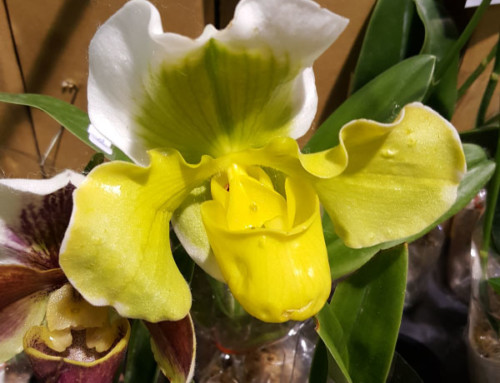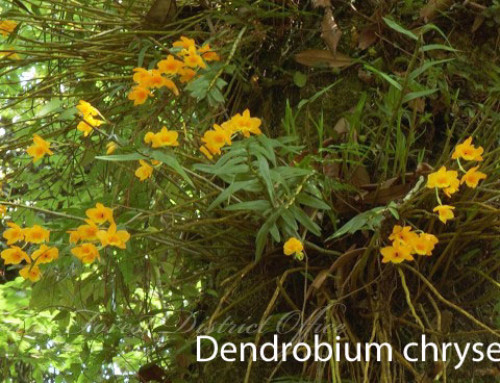notes recorded by Lia Andrews from Martin Motes’ video:
There are seemingly endless varieties of orchids. In fact, one in 10 flowers in the world is an orchid. Florida orchid growing is unique and requires special considerations for culture. It has a seasonal monsoon climate and is ideal for orchids native to mid-low elevation in the tropics.
DRYING OUT
Al conditions that make orchids grow are the same conditions that support their pests. To survive orchids evolved into a type of specialized cactus. They like to be fully wet, then dry out completely before wet again. This strategy works against the mortal enemy of orchids: fungus. Fungus requires constant wetness and do not survive the drying out periods. How much do orchids need to dry out?:
- Cattleyas and dendrobiums like to dry out hard. They like to get bone dry. “If you think it needs to be watered, wait a day.”
- Paphiopedilums and phalaenopsis like to maintain a little wetness. Water when just starting to dry out. “If you think it needs to be watered, you should have watered it yesterday.”
- Vandaceous orchids are in between. “If you think it needs to be watered, water today.”
- white roots = dry
- green roots = wet
- Consideration must also be made for potting media, pots, mounted orchids, etc. Most mounted or free hanging orchids often need daily watering in summer and every few days in winter. While the same orchids potted require less frequent watering.
Proper watering is the key to success with orchids, especially in Florida. (We discussed water quality in a previous blog post). Never water orchids unless they need it. It is better to err on the side of being too dry than too wet. Over-watered orchids are very prone to diseases. Unfortunately, there is no absolute rule. You must become a keen observer of weather, seasonal changes, and microclimates within your growing space. You must also get to know each orchid in your collection.
For potted orchids, Motes recommends lifting your orchids daily to get a feel for the weight of a wet versus dry plant. When the pot becomes as light as possible, water it. Remember that media that is very dry repels water, and this also happens to the orchid’s roots. Once the orchid has dried out you will need to fully saturate it with water to get it properly hydrated. Motes recommends watering twice. Begin at one end of your collection, watering until you see runoff. When you reach the end, start over at the beginning of your collection and re-water until you see runoff.
FERTILIZER
Fertilizer is applied exactly the same way as you water; twice, saturating the roots/media each time. Time release fertilizers offer low maintenance but you need to be careful to get one that withstands the relentless summer rains of Florida. Time release fertilizer are only as good as the polymers holding it in. Motes recommends Dynamite from Home Depot or a low phosphorus one marketed for avocados and citrus from Lowes.
Common consensus has moved away from 20-20-20 fertilizer for orchids; though you can use this a little in the spring. Studies at Michigan State* show that orchids grow and flower best with fertilizers low in phosphorus, nitrogen, and potassium. On the other hand, orchids need more calcium (naturally high in Florida water) and magnesium. (American fertilizers do not list these minerals, while in Europe magnesium is the 4th number listed.)
You can use Peter’s Excell 15-5-15, or one of the many orchid fertilizers based on the Michigan State studies, like this one from RePotMe.com. Avoid bloom boosters which are high in phosphorus.
When temperatures drop to the 60°s F and below, we often observe the leaves get red spots due to cold exposure. This is in fact the plant experiencing magnesium deficiency symptoms. If you see these red spots, you can use 1 tbsp. of Epsom salts per 1 gallon of water every week until the leaves regain their normal color.
POTS
- Plastic
- growers love them = they are cheap, don’t break, and light. The downside in Florida is they hold too much moisture.
- Clay
- transpires out moisture so that it fully dries itself and the contents of the pot out. It is also cooler.
Besides the extra consideration for dryness, orchids are a unique plant in another way. In most plants, the bigger the pot, the happier the plant. Because orchids need to fully dry out, you want to pot them in the smallest pot possible, then repot them every 1-2 years in the next pot size up. Keep in mind that a 6″ pot is actually seven times the volume of a 3″ pot. (Society VP, Gary Murza, recommends repotting yearly in Florida due to the inevitable salt buildup that occurs here).
Whether you buy your orchids from big commercial grower like Home Depot or a boutique grower, if it is in a plastic pot repot it in a clay pot immediately. Orchids are now being mass produced creating vertical competition. Big commercial growers will grow their orchids in a 4″ pot then repot them in a 6″ right before putting them out for sale. It is good for marketing, but bad for the orchid.
The depth of the pot is also important. In a standard pot, height = width. In a bulb or azalea pot, 1/2 height = width; which is much better for the orchids. Fancy orchid pots are also an option, just remember that every once in a while you need to smash a pot in order to safely remove the orchid. (Perhaps save your fancy pots for bonsai).
A solid clay pot is better than a slotted clay pot because it sweats better. Also, many times when you buy an orchid it will have extra stuff like Styrofoam at the bottom for “drainage” and to make a regular pot function more like a bulb pot. This actually impedes drainage and is very bad for the orchid. Repot in a shallow pot like a bulb pot.
MEDIA
Growers who move to Florida from other areas quickly learn that media requirements are different here. The gold standard in Southwest Florida used to be tree fern. It lasts 4-5 years, but it is harvested from an endangered species. Motes uses a mixture of 50% charcoal and 50% coconut husk. Other choices are Aliflor (holds more water), solite, and charcoal. (I personally like the these 2 mixes from Broward Orchid Supply).
Many orchids we purchase are potted in sphagnum moss. This is the surest way to kill an orchid in Florida. Sphagnum moss only lasts about 1 year here until it begins to decompose, flattening and packing in water with no air, rotting the orchids’ roots. The moss is often 1 year old or more by the time the orchid is sold. Fern rock and bark, favorites up north, is also certain death in South Florida. (Special bark that can survive our weather is available locally).
Another solution is simply to mount orchids on wood, trees, rock, pots, or to hang them freely.
The video continues on to discuss light and air movement, two additional important considerations.
*The study found that 13-3-15 (for rainwater or reverse osmosis) and 19-4-23 (for well water) gave the best results. Read the full article in Orchids Magazine here.



